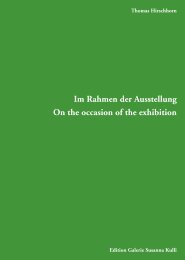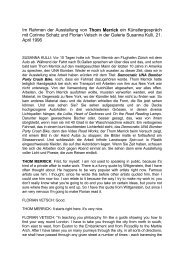Im Rahmen der Ausstellung - Galerie Susanna Kulli
Im Rahmen der Ausstellung - Galerie Susanna Kulli
Im Rahmen der Ausstellung - Galerie Susanna Kulli
You also want an ePaper? Increase the reach of your titles
YUMPU automatically turns print PDFs into web optimized ePapers that Google loves.
got any response. First, we were free to do it with no one having the critical knowledge<br />
to comment on it. That was an advantage, but also it was more interesting to<br />
create a situation with local references. Probably that helped in a way, in fact doing<br />
things with other people. That is a little singularity in the «ECART» thing, that it<br />
did not come from a group of artists with a statement or an artistic program. That<br />
was the case of most of the relations with groups or individuals we were affiliated<br />
with; they had a kind of statement which was very directly towards their philosophy.<br />
In our case it was just school friends who grew into doing different things<br />
together, and we ended up doing also art or what was taken for art. That’s a sort of<br />
a special function which also made it go on for quite a long time, which<br />
I think is not the case, for example, for friends of mine like B.M.P.T., Buren, Mosset,<br />
Parmentier, Toroni. That was a very political statement within the art field but<br />
maybe also outside the art field. In our case this sort of special activity was not so<br />
present. This goes back to what you were saying before, how things spread over or<br />
dissolve into other kinds of activities. But not to compare with what is happening<br />
today: we always have this tendency to notice things at which we beat each other,<br />
and technically this is true but practically it’s wrong. Or vice versa, I don’t know. I<br />
think that people today who create forms which have some similarity with what we<br />
used to do in the sixties, and those forms are quite present today, come from a totally<br />
different context, the references are totally different and they have anot her<br />
model. So the background and the grounding of it is fundamentally different.<br />
Bice Curiger: That brings us to words like recycling or interference, I think you’ve<br />
put some thought into these terms, using them in making and producing objects,<br />
and in arranging objects of other artists as a curator.<br />
John M Armle<strong>der</strong>: I think, right from the beginning I never really made a big difference<br />
between what I was doing and what I was seeing, because basically when<br />
you look at something, when you see something, you are taking it over and you are<br />
making it your own. When you are doing something you are choosing something<br />
which has been given to you to display. I had a facility to abuse my cultural heritage<br />
in a way. It looks very often like recycling, I’m not certain if one can really<br />
put it like that. Of course, in the eighties it was fashionable to talk about recontextualization<br />
and so on. It’s true that if you look at some things I’m doing systematically,<br />
it has all the appearance of that. At very low levels, for instance, when I<br />
re-use a lost piece of furniture which is going to be dumped, and I avoid its<br />
ending up in the gutter and bring it to a museum, then it’s high recycling. But this<br />
has never, of course, been the main topic. It’s one of the ironical anecdotes about<br />
what one does. You also may see it here in some of the works on paper because the<br />
papers are obviously waste. There is this tradition, especially in Switzerland, using<br />
all bits of paper to do scribbles and drawings, it’s very obvious in some of my





